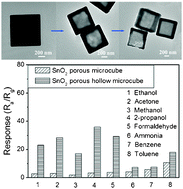Preparation of hollow porous Co-doped SnO2 microcubes and their enhanced gas sensing property†
Abstract
Hollow porous Co-doped SnO2 microcubes were achieved by a template-free chemical solution route combined with subsequent alkali-washing,

* Corresponding authors
a
College of Chemistry and Materials Science, Anhui Key Laboratory of Functional Molecular Solids, Anhui Normal University, Wuhu, P. R. China
E-mail:
jrhuang@mail.ahnu.edu.cn, cpgu2008@mail.ahnu.edu.cn
Fax: +86 5533869303
Tel: +86 5533869303
b Research Center for Biomimetic Functional Materials and Sensing Devices, Institute of Intelligent Machines, Chinese Academy of Sciences, Hefei 230031, P. R. China
Hollow porous Co-doped SnO2 microcubes were achieved by a template-free chemical solution route combined with subsequent alkali-washing,

 Please wait while we load your content...
Something went wrong. Try again?
Please wait while we load your content...
Something went wrong. Try again?
J. Huang, L. Wang, C. Gu, M. Zhai and J. Liu, CrystEngComm, 2013, 15, 7515 DOI: 10.1039/C3CE41148F
To request permission to reproduce material from this article, please go to the Copyright Clearance Center request page.
If you are an author contributing to an RSC publication, you do not need to request permission provided correct acknowledgement is given.
If you are the author of this article, you do not need to request permission to reproduce figures and diagrams provided correct acknowledgement is given. If you want to reproduce the whole article in a third-party publication (excluding your thesis/dissertation for which permission is not required) please go to the Copyright Clearance Center request page.
Read more about how to correctly acknowledge RSC content.
 Fetching data from CrossRef.
Fetching data from CrossRef.
This may take some time to load.
Loading related content
